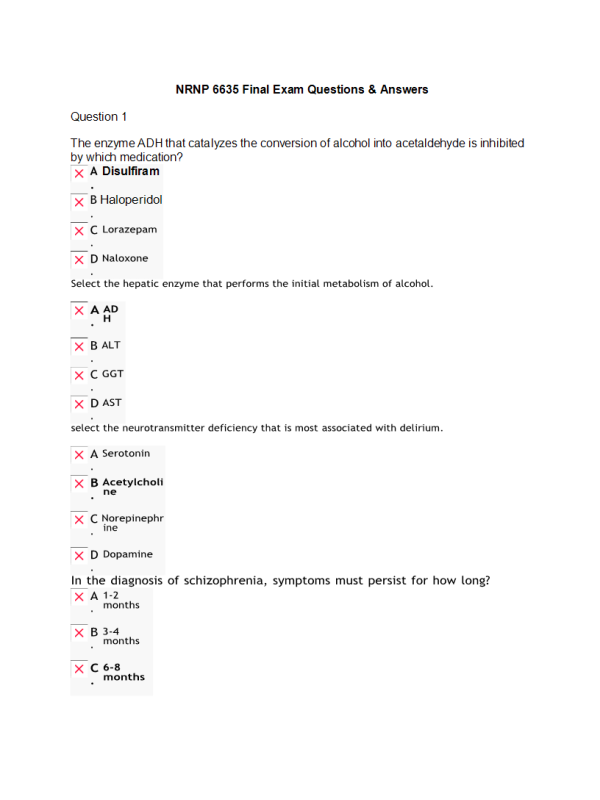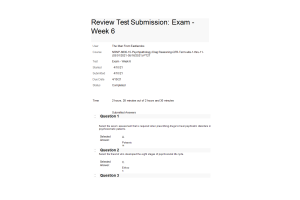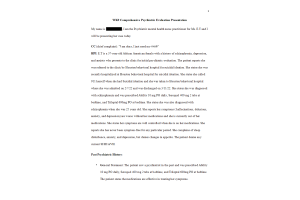NRNP 6635 Week 11 Final Exam
Course : Course
Contributed : Deanna Fussi
- $35.00
- Question: The enzyme ADH that catalyzes the conversion of alcohol into acetaldehyde is inhibited by which medication?
- Question: Select the hepatic enzyme that performs the initial metabolism of alcohol.
- Question: Select the neurotransmitter deficiency that is most associated with delirium.
- Question: In the diagnosis of schizophrenia, symptoms must persist for how long?
- Question: Select the drug that is least likely to cause male sexual dysfunction.
- Question: What substance is known to decrease blood concentrations of antipsychotics, yet improve cognitive impairments and parkinsonism in schizophrenia illnesses?
- Question: Select the drug that is most likely to cause parkinsonian movement symptoms.\
- Question: Select the procedure most applicable to confirming a diagnosis of delirium.
- Question: Differential diagnoses for consideration when assessing gender dysphoria in adolescents and adults include all of the following EXCEPT
- Question: Heavy use of cannabis in individuals with no previous psychiatric illnesses can produce:
- Question: Bleuler identified “Four As” as fundamental symptoms of schizophrenia to frame his theory of internal mental schisms of patients that include all the following EXCEPT:
- Question: Select the two defense mechanisms used commonly by patients with personality disorders.
- Question: Elect the preferred drug used to treat alcohol withdrawal.
- Question: What is the term that describes the ability of one drug to substitute for another?
- Question: Select the youngest age at which childhood-onset schizophrenia can be distinguished from autism spectrum.
- Question: Select the time of onset for tolerance to develop from continuous use of hallucinogens such as LSD.
- Question: Select the characteristic of sexually abused children.
- Question: Select the primary method to assess cognition.
- Question: All of the following are subtypes of schizophrenia EXCEPT
- Question: Select the drug most likely to be effective treating paraphilic disorders.
- Question: What is the term for patients who mimic mental health symptoms without having the disorder for secondary gain?
- Question: Select the factor associated with a four- to five-fold greater occurrence of gender dysphoria in male than in female children.
- Question: Select the age at which sexual identity is self-evident.
- Question: What laboratory test assists with the diagnosis of schizophrenia?
- Question: What is known as the peak age of onset for schizophrenia in males?
- Question: Select the most common error by the provider in the practice of family-oriented therapy for persons with schizophrenia.
- Question: Select the neurotransmitter for which the metabolite 5-HIAA in CSF is evident and predictive of suicide
- Question: Select the personality disorder in which patients are preoccupied with perfectionism and interpersonal control.
- Question: Select the drug most likely to inhibit female orgasm.
- Question: Select the epidemiologic characteristic of tardive dyskinesia symptoms.
- Question: Elect the personality disorder in which patients exhibit covert obstructionism, procrastination and pessimism.
- Question: What is the terminology term for the dream-like state of patients with schizophrenia who are engaged in their hallucinations and exclude involvement in the real world?
- Question: Select the most frequent cause of infant and childhood intellectual disability that is attributed to a specific gene
- Question: Elect the psychiatric disorder in which patients refuse mental health care and deny their problems.
- Question: Select the most effective form of questioning when taking a sex history.
- Question: Elect the medical condition in which erectile dysfunction drugs (e.g., sildenafil) are likely to be ineffective.
- Question: Select the infectious disease that when untreated may lead to an incorrect diagnosis of depression.
- Question: Select the two patient populations most likely suffer neuroleptic-induced parkinsonian symptoms.
- Question: Select the brain region devoid of cannabinoid receptors.
- Question: Select the factor that best correlates with attempted and completed suicide.
- Question: Select the personality disorder that is assigned to Cluster B in DSM-5-TR.
- Question: Select the brain region that is associated with substance addiction.
- Question: Select the two essential features of sexual dysfunction.
- Question: Select the characteristic that is greater in childhood than adult onset schizophrenia.
- Question: Select the main goal of psychosocial therapies for persons with schizophrenia.
- Question: Select the type of neurochemical receptor that is blocked by caffeine.
- Question: Select the two normal functions in Asperger’s Disorder that are absent in Autism Spectrum Disorder
- Question: Select the mental function that is most affected in mild cognitive impairment.
- Question: Select the substance of abuse with the strongest evidence for genetic association.
- Question: Select two treatments for adults who identify as transgender.
- Question: Select the two characteristics that describe normal sexual behavior.
- Question: Select two terms preferred to describe sexual orientation.
- Question: Select the personality disorder in which patients are most likely to tolerate spousal abuse to avoid losing sense of attachment.
- Question: Select the neurotransmitter system that is most associated with the addictive rewarding properties of opioids.
- Question: Select the psychiatric emergency that is indicated by mothers who express inadequate distress over their children’s medical symptoms.
- Question: Select the drug of choice to treat psychosis in delirious patients.
- Question: Select two comorbid factors common in schizophrenic patients.
- Question: Select the neurotransmitter that increases sexual desire



